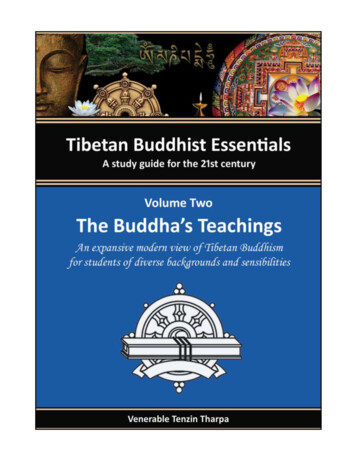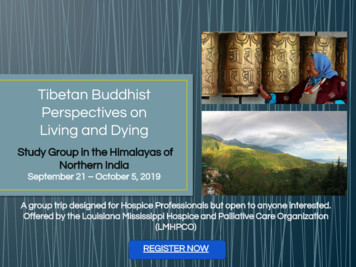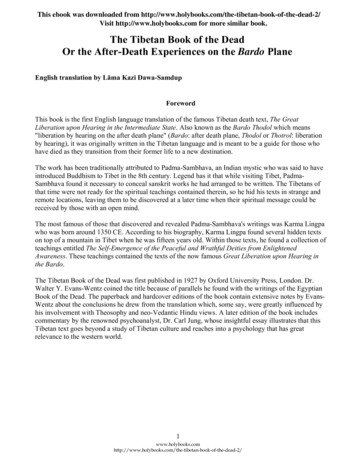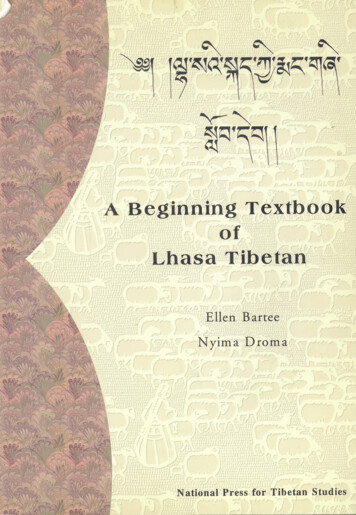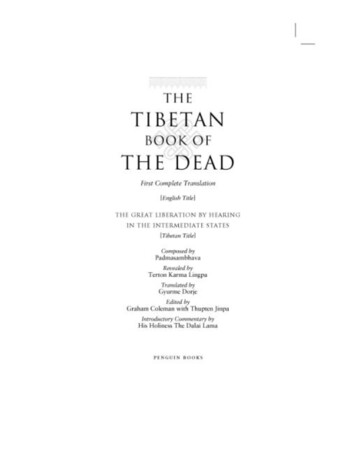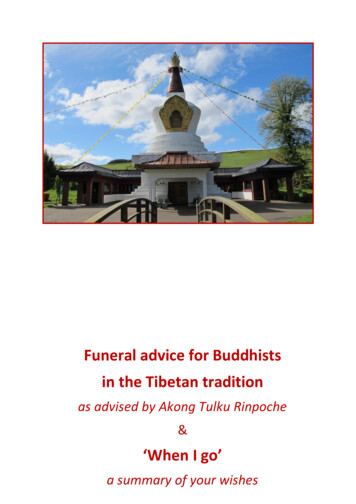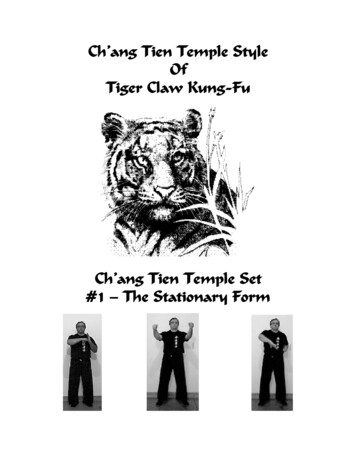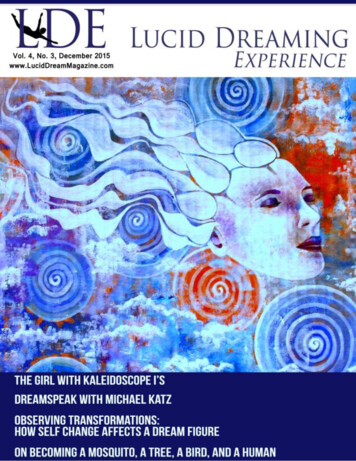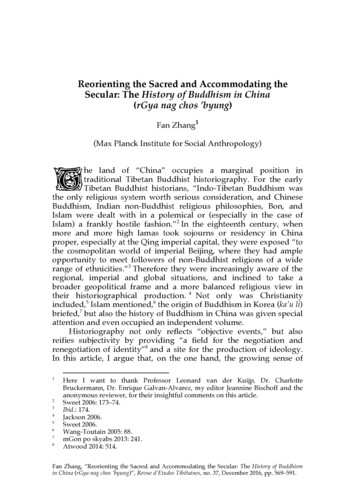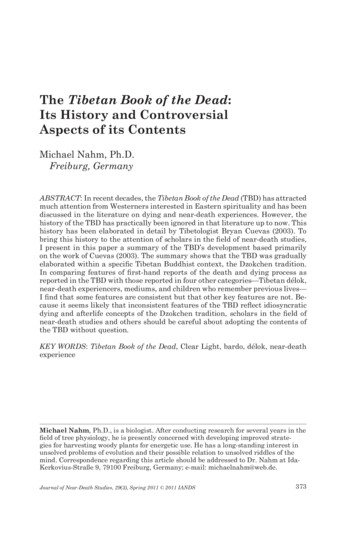
Transcription
The Tibetan Book of the Dead:Its History and ControversialAspects of its ContentsMichael Nahm, Ph.D.Freiburg, GermanyABSTRACT: In recent decades, the Tibetan Book of the Dead (TBD) has attractedmuch attention from Westerners interested in Eastern spirituality and has beendiscussed in the literature on dying and near-death experiences. However, thehistory of the TBD has practically been ignored in that literature up to now. Thishistory has been elaborated in detail by Tibetologist Bryan Cuevas (2003). Tobring this history to the attention of scholars in the field of near-death studies,I present in this paper a summary of the TBD’s development based primarilyon the work of Cuevas (2003). The summary shows that the TBD was graduallyelaborated within a specific Tibetan Buddhist context, the Dzokchen tradition.In comparing features of first-hand reports of the death and dying process asreported in the TBD with those reported in four other categories—Tibetan délok,near-death experiencers, mediums, and children who remember previous lives—I find that some features are consistent but that other key features are not. Because it seems likely that inconsistent features of the TBD reflect idiosyncraticdying and afterlife concepts of the Dzokchen tradition, scholars in the field ofnear-death studies and others should be careful about adopting the contents ofthe TBD without question.KEY WORDS: Tibetan Book of the Dead, Clear Light, bardo, délok, near-deathexperienceMichael Nahm, Ph.D., is a biologist. After conducting research for several years in thefield of tree physiology, he is presently concerned with developing improved strategies for harvesting woody plants for energetic use. He has a long-standing interest inunsolved problems of evolution and their possible relation to unsolved riddles of themind. Correspondence regarding this article should be addressed to Dr. Nahm at IdaKerkovius-Straße 9, 79100 Freiburg, Germany; e-mail: michaelnahm@web.de.Journal of Near-Death Studies, 29(3), Spring 2011 2011 IANDS373
374JOURNAL OF NEAR-DEATH STUDIESA nobleman asked Master Hakuin: “What happens to the enlightenedman at death?” He replies: “Why ask me?” The nobleman: “Becauseyou are a Zen-Master!” Hakuin: “Yes, but not a dead one!”A Zen ParableIn recent decades, Tibetan Buddhism has attracted much interest andmany followers in the Western world. This interest resulted largelyfrom the publication of the Tibetan Book of the Dead (TBD) by Walter Yeeling Evans-Wentz and Lama Dawa Samdup in 1927. To date,the TBD is the most read treatise of Tibetan Buddhism outside Tibet(Cuevas, 2003). After the Chinese occupation of their country, Tibetans received worldwide attention for the first time. Their cultural andspiritual traditions attracted and continue to attract the further interest of many Westerners dissatisfied with, or finding enhancementto, their own traditions.Not surprisingly, the Tibetan concept of dying and the afterlife presented in the TBD has also been discussed in a number of publications addressing its relation to near-death experiences (NDEs; e.g.,Becker, 1985, 1994; Carr, 1993; Jorgensen, 2006; Lee, 2004; Masumian, 2009; Murphy, 2006; Ring, 1993; Rinpoche, 1992; Varela, 1997;Wilber, 1990). Some authors and many Western followers of TibetanBuddhism hold the opinion that the TBD conveys a universally validand objectively verifiable truth about dying and the afterlife (e.g.,Coleman & Jinpa, 2006; Evans-Wentz, 1927; Govinda, 1993; Thurman, 1994; Wilber, 1990; personal experiences). In addition, mostTibetan Buddhists and many of their followers, but also critics (Murphy, 2006), have assumed that the author of the TBD was the legendary Indian guru Padmasambhava, who promoted Buddhism inTibet during the 8th century. Because the TBD contains descriptionsof experiences different from NDEs, Tibetan lamas and some of theirWestern followers have expressed the belief that NDEs are not factually related to dying but are experiences still belonging to the livingstate (Rinpoche, 1992; Varela, 1997). Francisco Varela (1997) went onto say that the skeptical considerations of the Dalai Lama regardingcurrent studies and interpretations of NDEs are a strong caveat toWesterners, indicating that these studies might be misdirected andraise wrong expectations of what will happen during and after dying.Thus, in light of the teachings of the TBD, Varela recommended an“entire re-evaluation of the Western approach to NDEs,” because thecommon understanding of NDEs might be based on “rather hasty interpretations” (p. 216).
MICHAEL NAHM375However, old texts like the TBD usually have a vivid history, often leading to distortions and embellishments associated with thespecific sociocultural and political background in which they developed. Thus, one should be careful about regarding such scriptures assources of ancient universal truths before critically examining theirhistory and contents.The history of the TBD has been elucidated in a painstaking studyby Tibetologist Bryan Cuevas (2003), containing about 900 footnotesand listing almost 450 Western references—not counting the manyreferences available only in Tibetan, Indian, or Chinese language.Among scholars, this book is regarded as a seminal work (for bookreviews, see e.g. Gray, 2004; Prats, 2005; Schaeffer, 2005), and it hasbeen cited by several sources concerned with the history of the TBD(Cornu, 2009; Gyurme, 2006; Lopez, 2011). Cuevas argued that allthe TBD translators, commentators, and interpreters have so far neglected its history in favor of presenting three interrelated approachesdesigned to fit modern Western thinking: scientific, psychological,and humanistic. The scientific approach was originally put forwardby the first editor of the TBD, Evans-Wentz (1993), who stated thatthe TBD is mainly a scientific book “based on provable facts of humanphysiological and psychological experiences” (p. 110, my translation).Robert Thurman (1994) also stressed this attitude, among others: Hedesignated the TBD “a scientific handbook on the realities and experiences of death” (p. 51). In a more recent edition of the TBD, GrahamColeman represented this perspective in stating thatthe insights that are presented here come from those who have realised the ultimate nature of mind and thereby have experiential understanding of the processes of the mind in deep sleep, dreams, thewaking state and throughout the process of dying and beyond. (Coleman, 2006, p. xxx)Evans-Wentz also stressed the psychological background of theexperiences described in the TBD. The most influential author to interpret the TBD in psychological terms was Carl Gustav Jung. In his“Psychological Commentary” on the TBD, Jung (1993) wrote that thebook was “entirely created by the archetypical contents of the humansubconscious” and, thus, provided access to the universal structuresof the human psyche (p. 55, my translation). Jung’s psychological interpretation of the TBD appears to have strongly influenced following editions and commentaries on the TBD, including the editions byFremantle and Trungpa (1975) and Lauf (1977).
376JOURNAL OF NEAR-DEATH STUDIESThe humanistic approach focuses on the potential self-transformation that individuals could realize by proper study, understanding,and practice of the TBD’s instructions. Lama Govinda (1993) exemplified this view by stating, “Under the guise of the science of death,the Bardo Thödol reveals the secret of life. Therein lies its spiritualvalue and universal importance” (p. 37, my translation). Thus, heviewed the TBD not only as a book designed to be addressed to thedying and dead but also as “a guide for initiates, and for those whoare seeking the spiritual path of liberation” (p. 32, my translation).According to Cuevas (2003), the authors stressing the humanistic approach aimed at presenting ever more accessible versions of the text,resulting in an “easy-to-read and tradition-authorized ‘guidebook forspiritual practice’” (p. 12). Govinda (1993) even argued that the Tibetan tradition of helping the deceased’s soul on its path to liberationby reading particular TBD texts in the vicinity of the corpse is basedon a misunderstanding that resulted from the ignorance of Tibetansregarding ancient initiation rites and the text’s true spiritual meaning for the living.However, according to Cuevas (2003), the TBD was compiled gradually and consists of a mix of locally determined materials that reflectthe respective interests of specific traditions and monasteries. Theseaspects of the TBD’s history are still neglected in much of the recentcontemporary literature on it. For example, in the already-mentionedrecent translation, Coleman (2006) maintained that “the complete Tibetan Book of the Dead is a comprehensive guide to both living anddying as originally taught by . . . Padmasambhava” (p. xxix), and inthe inner title page of the book the editors credited Padmasambhavaas the “composer” of the translated set of texts. Moreover, Colemanclaimed that “the compendium of texts” known as the TBD representan “abridgement” of the original texts ascribed to Padmasambhava(p. xl). Curiously, although Cuevas came to conclusions quite the opposite of Coleman’s, Cuevas’s work is cited approvingly in the historical sketch of the TBD in the same book (Gyurme, 2006).To date, the history of the TBD has remained largely unknown andneglected in the field of near-death studies. To introduce the readerto that history, I first provide a summary of the TBD’s developmentbased on the work of Cuevas (2003). After this historical overview,I compare features of claimed first-hand dying and afterlife experiences as reported in the TBD with those features as reported in NDEresearch and survival research.
MICHAEL NAHM377The History of the Tibetan Book of the DeadThe following summary of the history of the TBD is derived primarily from Cuevas (2003). Additional references indicate material notderived exclusively from his work.Pre-TBD Tibetan Beliefs about Postmortem StatesPrior to the appearance of the TBD, proponents of early Indian Buddhist traditions were already engaged in controversy regarding thestatus of an intermediate state between death and rebirth. Amongothers, devotees of the Theravada school rejected claims of such astate of existence. In fact, the Buddha never explicitly taught the existence of an intermediate state, although some formulations mightbe interpreted as such. Thus, proponents of other schools such as theSarvastivada and the Sautantrika postulated its existence, but theystill disagreed about how it should be understood. Formulated doctrinal expositions on the intermediate state existed as early as the 2ndcentury, for example in the voluminous book Mahavibhasa.One of the most influential texts to emerge in the following centuries was authored by the prominent Buddhist teacher Vasubandhu inthe 5th century. Motivated to compile all arguments that favored existence of the intermediate state and to settle differences about howit should be conceived, Vasubandhu developed a theory that became astandard presentation of early Indian views on postmortem states. Itwas adopted in the late 7th century in Tibet during the initial phasesof the introduction of Buddhism. In general, this theory was based onSarvastivada theories that implied four stages or intervals in the lifecycle of sentient beings: (1) birth, (2) the period from birth to death,(3) death, and (4) the period from death to rebirth. For the latter interval, Vasubandhu described characteristics that also appeared inlater Tibetan texts. For example, beings living in this intermediatestate said to be visible only to other discarnate beings and to clairvoyants. Also, these beings supposedly eat odors, thus the Tibetan term“hungry ghosts.” These beings are hungry but cannot eat; therefore,they feed on the odors of burnt oblations. Moreover, beings in theinterval from death to rebirth are said to be drawn to their next existences when they perceive their future parents having sex. In addition to Vasubandhu’s text, other important texts on intermediatestates also existed in India, some listing up to 17 such states for onelife cycle.
378JOURNAL OF NEAR-DEATH STUDIESConcepts of the human afterlife prevailing in Tibet in pre-Buddhisttimes remain obscure. Certainly, attitudes towards the spirits of thedeceased were strongly dominated by fear. Tibetans feared that spirits without a physical body become mischievous and seek to recovertheir lost life force by taking it back from the living, often from theirown relatives. Thus, Tibetans developed funerary rituals that included overt techniques to safeguard the soul of the deceased alongits path to its destiny and to restrain it from malicious ambitionstowards previous family members.However, the earliest Tibetan texts on funerary rituals, datingfrom the late 8th century, already showed Buddhist influences. Theolder indigenous concept of two opposing realms of gods and ghostshad been adapted to the concept of rebirth in the round of existence,Samsara. According to the manuscript Showing the Path of the Dead,the soul of a deceased person can follow one of three negative postmortem paths—to hell, to the realm of hungry ghosts, or to the realmof animals—or can follow a fourth path leading up to the realm thedeceased should strive to reach: the realm of gods. Family membersare advised to assist the wandering soul of the deceased by calling hisor her name, by giving instructions on the path to follow, and by reminding the appropriate mantras to recite. Such early texts show thecontinuity and blending of pre-Buddhist concepts about the afterlifeand of funerary rites of more sophisticated Tibetan Buddhist traditions of later times.The assumption that these pre-Buddhist concepts are representedby the so-called Bön tradition appears to be mistaken. In fact, theprevailing opinion among current Tibetologists—yet not among theBönpo themselves—is that Bön represents an alternative form ofBuddhism that developed into an organized and distinctive religioustradition in deliberate opposition to other Buddhist sects. This development occurred no earlier than the late 10th century—that is,after the so called “Dark Age” of Tibet that lasted from the middleof the 9th to the late 10th century when Buddhism was deprived ofits rank as the official religion in Tibet. Most likely, Bön was onlyretroactively designated as an alleged pre-Buddhist tradition in Tibet(Cuevas, 2003, 2008; Kvaerne, 2002).In Northern India, the Buddhist concepts of the intermediate statebetween death and rebirth as established in the 5th century wereamended only slightly until the tantric cults spread across this regionin the 7th and 8th century. The tantras are a huge set of unorthodoxesoteric texts on various matters of spiritual practice. These tantric
MICHAEL NAHM379traditions were introduced into Tibet through convoluted pathwaysbeginning in the 11th century and contributed to the formation ofnumerous competing sects during the renaissance of Buddhism afterthe Dark Age.A significant tantric innovation concerning the intermediate statebetween death and rebirth was its division into distinguishable intervals. Important Indian teachers whose concepts shaped the Tibetanreinterpretations of the intermediate state were Tilopa ( 988–1069)and his follower Naropa ( 1016–1100), whose chief disciple was theTibetan translator Marpa ( 1012–1097). Marpa introduced a newconcept of this intermediate state into Tibet and transmitted it toa disciple famous throughout the country, Milarepa ( 1040–1123).However, at least 15 different Tibetan traditions of instructional advice on the postmortem intermediate state, the postmortem bardo,existed in the 13th century. Tilopa aimed at organizing different tantric instructions into a coherent system; it included “deity yoga” asthe most effective practice to block “the womb door”—that is, reincarnation. Deity yoga refers to meditation practices to generate visualizations of specific Buddhist deities. Naropa developed Tilopa’sconcept into further complexity, and he advised yogic practitionersto recognize the Clear Light as a means for liberation. But it appearsthat only in the instructions of Marpa was the experience of the ClearLight directly linked to the bardo beginning at the moment of death.Moreover, this Clear Light was said to be only recognizable for thosewho achieve instant enlightenment at this moment—“superior” yogis;others would have to proceed with deity yoga and other meditationpractices in the bardo. Milarepa put forward a further proliferation ofdifferent bardo states. He introduced many subcategories, suggestingthat all major experiences of existence could be divided into a gradedseries of intermediate states.However, by the middle of the 13th century, a sixfold structure ofthe bardos experienced within one cycle of Samsara became the preferred format in many Buddhist traditions. Still, these conceptionsof the six different bardos were often not congruent, and other bardoclassifications ranging from two to five also existed.A specific sixfold bardo concept of particular relevance for theTBD developed within the Tibetan Dzokchen tradition in parallelto the tantric transmission lines. In Dzokchen cosmogony, a groundluminosity often described as Clear Light lies at the bottom of allexistence. Stirred by a primordial gnostic wind, the cosmos beginsto spiral outward from this fundamental ground, beginning with the
380JOURNAL OF NEAR-DEATH STUDIESmanifestation of five rainbow-colored lights, at some point leading tothe emergence of the five elements that constitute physical matter. Ifbeings fail to recognize the fundamental nature of the cosmos as luminous radiance, which in fact is also their own fundamental nature,dualistic awareness sets in. They begin to perceive subjects and objects and to enter the cycles of Samsara. However, the Clear Light ofreality itself remains always present. It is said to be experienced—ifonly in glimpses and not in its entirety—in various altered states ofconsciousness or in the transitions leading to them, such as in fainting, in sneezing, in the first instants before and after dreaming, andduring orgasms. But the primordial Clear Light in its entirety couldbe experienced only at or immediately after the moment of dying—and in profound states of meditation specifically designed to apprehend it.In contrast to postmortem bardo concepts of other Tibetan traditions, in Dzokchen the concept of the brief moment of Clear Lightexperience at the moment of death was expanded to span an entirelynew conceptual space within the “bardo of reality itself.” Most notably, the experience of the vision of 100 peaceful and wrathful deities, a vital feature of the TBD, was inserted into this enlargenedbardo concept. During this vision, a defined sequence of peaceful andwrathful deities is supposed to appear in front of the deceased, eachdeity being characterized by specific colors and symbolic attributes.Typically, the deceased will react with strong emotions when encountering these visions and, especially in the later stages of this bardo,most likely with considerable fear. Therefore, the frightened wanderer in the bardo is continuously instructed by a lama sitting nextto the dead corpse to recognize the appearing figures as subjectivelyproduced illusions. These deities belong to a particular visualizationset for meditation that originated in Mahayoga tantras and that wasembellished and inflated in the manner described in the TBD onlywithin the Dzokchen tradition. By the 14th century, the experience ofthis mandala had become established as an essential feature withinthe Dzokchen concept of the “bardo of reality itself.”It is important to note that the primordial Clear Light in Dzokchenis not associated with any color or light in the usual sense. Rather, itrepresents the fundamental source of everything including color andlight. It is regarded as a colorless and featureless presence, or a verysubtle non-dualistic state of awareness or mind difficult to describe.For instance, Tenzin Wangyal Rinpoche (1998, p. 146) described theClear Light as the unity of emptiness and clarity in which “Clear”
MICHAEL NAHM381refers to the primordial emptiness at the foundation of existence and“Light” to clarity and pure innate awareness. In Coleman and Jinpa(2006), the original Tibetan term ‘od-gsal is not translated as ClearLight but as “Inner Radiance” (pp. 227ff) that is the essential natureof all cognitive events (p. 478).Emergence of the TBDHaving provided a general outline of the developments that haveshaped beliefs about postmortem states in Tibet prior to the emergence of the TBD, I now briefly describe the history of the TBD itself. It is said that its scriptures were authored and hidden by thefamous yogi Padmasambhava in the 8th century and excavated againby an obscure visionary, Karma Lingpa, in the second half of the 14thcentury. Traditionalists assume that enlightened lamas thereaftertransmitted these texts until their recent widespread publication.The texts assembled in the TBD are originally entitled Great Liberation upon Hearing in the Bardo and are embedded in a much largertext collection entitled The Self-Liberated Wisdom of the Peaceful andWrathful Deities. However, the original texts at the heart of the GreatLiberation upon Hearing collection were not transmitted unchanged.The primordial scripts must have been comparatively small and wereembellished and supplemented to a degree that it is now impossibleto trace. It is likely that some of the ritual prayers usually found inthe appendix of the TBD constitute the primary conceptual nucleusof the scriptures constituting the Great Liberation upon Hearing collection. Karma Lingpa himself may have begun to comment and organize the original texts but had not completed the task by the time ofhis early death. Thus, only a short time after his death, others close tohim—most likely his father and son, who both outlived him for manyyears—reordered and revised the scripts.Over time, numerous other authors continued to extend, elaborate, comment upon, and reorder these texts. Most of the scripturesconstituting the Self-Liberated Wisdom collection were transmittedthrough several different transmission lines, each being adapted tothe respective attitudes of their sects and monasteries. On the contrary, the subset of texts constituting the Great Liberation upon Hearing set were exclusively transmitted through a single line of succeeding individuals who predominantly drew upon the bardo concept ofthe Dzokchen tradition. Among others, two lamas provided importantcontributions to the process of elaborating the texts: Gongra Lochen
382JOURNAL OF NEAR-DEATH STUDIESZenphen Dorje (1594–1654) and Peling Sungtrül Tshültrhim Dorje(1598–1669). Rikzin Nyima Drakpa (1647–1710) performed the final redaction and organization of the Great Liberation upon Hearinginto a layout that was appealing to many different Buddhist sects. Afew decades after his death, the technique to duplicate books by using wooden blockprints was established in Tibet and allowed for thedistribution of the Great Liberation upon Hearing throughout largeparts of the country. Different funeral liturgies and bardo conceptswithout the mandala of the 100 peaceful and wrathful deities alsoexisted at that time in Tibet but gradually lost importance. However,some have continued to be transmitted to the present day. A notableexample is the process of dying and the concept of the bardo states described in the literature of the Gelukpa sect of the Dalai Lama (Carr,1993; Dalai Lama, 2004; for details of these differences, see below).In the 1920s, Lama Dawa Samdup translated only a part of thetexts that constitute the entire collection of the Great Liberation uponHearing. In 1927, Evans-Wentz edited and published these translated texts that became famous under the title Tibetan Book of theDead. However, Tibetans who live in important monasteries in theIndian exile usually read to the souls of the deceased a text, the Religious Liturgy of the Self-Liberation of Karmic Latencies, that is notcontained in the translated selection of Wentz, Samdup, and followers. Instead, as Govinda (1993) assumed, the texts chosen for translation in the TBD are regarded as a set of meditation guidelines foradvanced Dzokchen practitioners.In sum, the bardo concept depicted in the Great Liberation uponHearing had developed over centuries, gradually unfolding within aspecific sociocultural context to its form in the translations and editions of the present day. Given its known history, the notion thatthe TBD consists of texts authored many centuries ago by Padmasambhava cannot be upheld. Moreover, the opinion that the TBD isbasically a scientific and psychological text leading to repeatable, verifiable experiences revealing the truth about dying and a putative afterlife state seems rather doubtful. In the following section, I identifyvarious features of the dying process and the afterlife as depicted inthe TBD and then compare those features to dying features reportedin other purported first-hand accounts.
MICHAEL NAHM383Dying and Afterlife Concepts of the Tibetan Bookof the Dead and Its ContextThe Dying Process as Described in the TBDand Associated DoctrineTo begin, I give a brief six-phase outline of the dying process and theexperiences during the postmortem bardo state according to the TBD(e.g., Coleman & Jinpa, 2006; Evans-Wentz, 1993) and the associateddoctrine. In most cases, I follow a description of the phase with contradictory perspectives from various sources.1) The dying process starts with the loss of the bodily senses in adefined sequence: The eyesight is lost first, then the ability to hear,then the sense of smell, followed by the sense of taste and, lastly, thesense of touch. Bodily death is complete when inhalation stops. According to Tibetan tradition, a human soul cannot stay in a corpsewithout breath and has to leave it.Comment: The sequence of the loss of senses differs in the contemporary literature on dying. It is generally assumed that the sense ofhearing is the last to function (Brayne, 2010; Varela, 1997). This assumption is in accordance with the conditions of trance states. Here,the sense of touch is often already lost when hearing is still possible.These findings may cast doubt on the reliability and the alleged universality of the Tibetan definition of the dying stages. However, inmy review of literature, I found no substantial reference to the loss ofsmell and taste in the course of the dying process.2) Briefly before or during the soul’s departure from the body afterbreathing has ceased, or, in the case of a period of unconsciousnessthat sometimes occurs after dying, when the soul resumes consciousness, the primordial Clear Light of reality itself dawns. This experience will usually pass in an instant but may also endure for a longerperiod of time if the dying person has been trained to comprehendthis state of awareness. The individual has only this one opportunityto recognize and maintain awareness of this primordial Clear Light;if one fails in this opportunity, one’s awareness subsequently bedims.Comment: The Gelukpa sect holds a somewhat different viewon this process. Here, the Clear Light usually does not emerge immediately after the cessation of breath. Prior to the experience ofthe Clear Light, a defined sequence of dissolution of elements commences, which gives rise to increasingly subtle and non-dualistic levels of consciousness. In the first phase, a vivid appearance of white
384JOURNAL OF NEAR-DEATH STUDIESemerges, followed by an appearance of a vivid red-orange in thesecond phase. In the third phase, a vivid black experience dawns,and only after this experience the subtlest of all states of consciousness manifests, the entirely non-conceptual and non-dualistic ClearLight. Only then, full bodily death has occurred (Dalai Lama, 2004,pp. 146–150). Whereas the Gelukpas write of only this single ClearLight experience, proponents of the Dzokchen tradition hold thatthis experience is followed by the experience of a secondary, dullerClear Light that appears after the experience of the primordial ClearLight has ceased (Carr, 1993, p. 73; Coleman & Jinpa, 2006, p. 232;Evans-Wentz, 1993, p. 173).3) After or during experiencing this Clear Light, the consciousnessof the dying person is freed from the physical body. At this point, theindividual may have veridical out-of-body experiences (OBEs)—seepeople surrounding the deathbed, etc. Usually, the discarnate individual will not recognize for some time that he or she has died andmay stray around earthly locations of personal importance.4) Soon after, the visions of deities from the mandala of the 100peaceful and wrathful deities will dawn. Also, imaginations ofheaven, hell, or otherworldly landscapes will arise according to theindividual’s culture, belief system, and Karma. Thus, these visionswill vary from individual to individual and are considered entirelysubjectively produced: The deceased is regarded as “the only spectator of a wonderful panorama of imagined visions” (Evans-Wentz,1993, p. 108, my translation). Yet, while in the bardo, the deceasedmay also meet other discarnate individuals, including relatives and/or friends (Rinpoche, 1990; Varela, 1997).Comment: There is an apparent contradiction in stating that thepostmortem bardo state is an entirely subjective production of thedeceased and acknowledging that the deceased can meet with otherdeceased people. Bardo visions that include meeting and communicating with other discarnate people cannot be classified as solely illusory. Thus, interpretations of the TBD resting on the assumption thatthe experiences of the postmortem bardo are completely subjectiveand of a purely psychological nature (e.g., Evans-W
In recent decades, Tibetan Buddhism has attracted much interest and many followers in the Western world. This interest resulted largely from the publication of the Tibetan Book of the Dead (TBD) by Wal-ter Yeeling Evans-Wentz and Lama Dawa Samdup in 1927. To date, the TBD is the most read treatise of Tibetan Buddhism outside Tibet (Cuevas, 2003).


